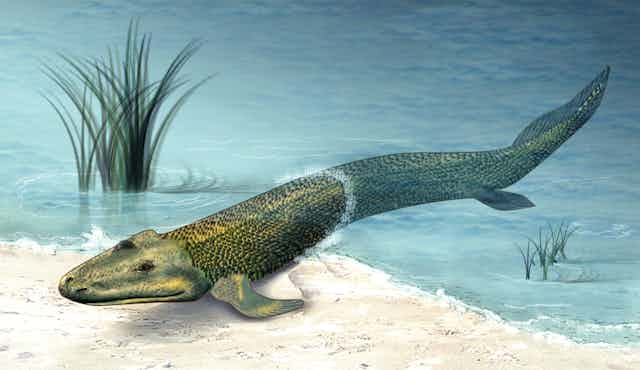It’s one of the most tantalising questions in evolutionary biology: how did our aquatic ancestors first move from water onto land?
Thanks to research published today in PLOS Biology, new light has been shed on this exciting area of biology.
Joost Woltering and colleagues from the University of Geneva compared modern day four-legged (tetrapod) limbs to fishy fins and found that limbs emerged though the modernisation of a pre-existing DNA structure.
In other words, ancient fish actually had the genes capable of producing limbs and digits – but these were not actually expressed until animals made the move onto land.
“This work has shown that although fish have similar gene regulatory toolkits to produce digits, the actual process is not activated until the evolution of four-legged animals, so the presence of fingers and toes remains a unique character of us land animals,” Flinders University’s John Long said.
What makes us different to fish?
The evolutionary changes that occurred some 350 million years ago, when fish fins transitioned into limbs, are still shrouded in mystery.
“This study will help us understand how the highly specified structure, such as a digit, could have evolved from a simple structure like a fin,” said Yann Gibert from Deakin University.
By looking at this video of the mud-skipper – an amphibious fish that walks using its strong pectoral fins– we can visualise how ancestral fishes first made their way out of the water onto land.
But to really understand the process, Woltering and his colleagues had to delve deeper – not just looking at the external structures of the animals, but the underlying DNA as well.
This area of biology, known as Evo-Devo, combines embryonic development and evolutionary theory. Evo-Devo sets out to determine the ancestral relationship between species, and understand how developmental processes evolved.
Woltering and colleagues were interested in the development of digits. By comparing this to genetic expression in the fish to a tetrapod limb, they hoped to uncover whether these structures were ancestrally the same (homologous.
“This new research represents a fascinating advance in our knowledge about the regulatory mechanisms surrounding one of evolution’s greatest events – the origin of four-legged animals, or tetrapods, from fishes,” Professor Long said.
Clues in the DNA: Hox genes
All fishes and land animals possess Hox genes. These are a set of genes responsible for the specification of embryonic cells – for instance, which part of the embryo will form the head, torso or limbs.
Woltering and colleagues where interested in a certain clusters of Hox genes, called HoxA and HoxD, that are involved in both fin and limb development.
HoxA and HoxD genes specify tissue structures along the proximal-distal axis (the axis running between your torso and fingertips). HoxA and HoxD genes are expressed in distinct waves to specify which cells become parts of the arms and legs.
However, these genes work differently in tetrapod development compared to fish development. In particular, the subdivision of bones to form digits is a defining feature of tetrapods, and is not present in fishes.

Differences in expression
Another key differences observed between fish and tetrapod limb development is the “bimodal expression pattern” of HoxD. This means half of the HoxD gene specifies the development of long bones above the wrist or ankle, while the other half specifies the area below the wrist or ankle (including fingers and toes).
In the current study, Woltering and colleagues examined whether this bimodality occurs in HoxA genes as well. They reasoned that if it did, the “bimodal expression pattern” arose before the move onto land – meaning the regulatory capacity to form digits arose before our aquatic ancestors left the ocean.
Although there were some differences between HoxA and HoxD expression, the researchers found enough bimodality in HoxA to conclude that the regulatory system arose before the move onto land.
This indicates that modern fish have the genetic capacity to form digits, but it is not expressed.
The next step
Woltering and colleagues must now investigate the mechanism behind their findings. They hypothesise that the ancestral DNA that is capable of producing limbs and digits is turned off in fish by a repressor.
“The next step would be to try and identify the repressors of the Hox gene in the distal part of the limb in the mouse – the repressor would still be active in the fish fin,” said Professor Gibert.
But for now, these findings add further intrigue to a fascinating part of our evolutionary history. We are now one step closer to understanding exactly how fish moved out of the water to become our first four-legged ancestor.

